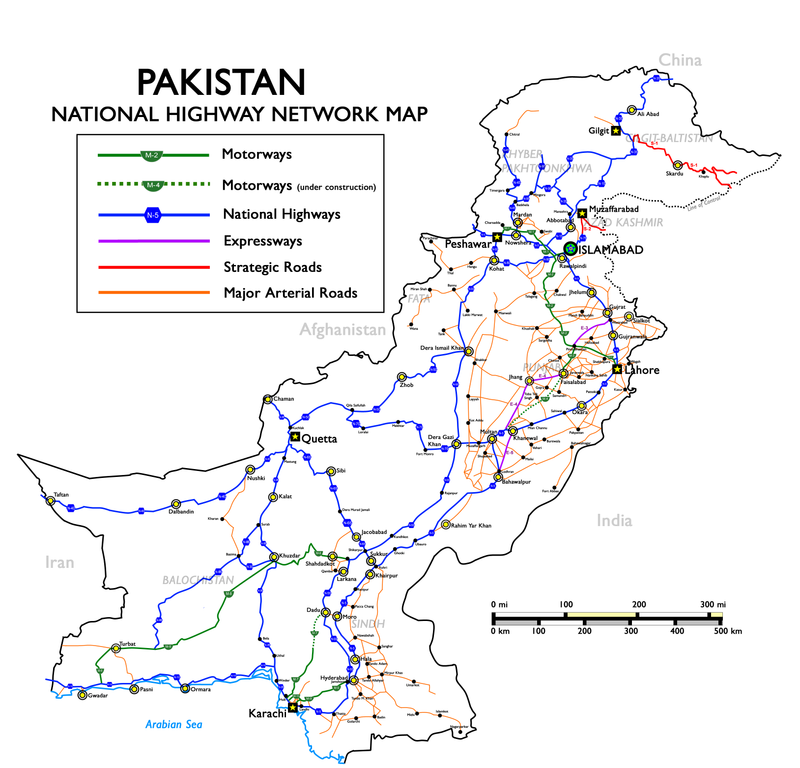Motorway network in Pakistan stands as a testament to the country’s commitment to modern transportation infrastructure. Spanning across diverse terrains and connecting major cities, this road network under National Highway Authority play a vital role in enhancing connectivity, trade facilitation and economic development. This article provide basic understanding of Pakistan road communication network, Its origination, significance, key features and future prospects.
Origination and Expansion:
Genesis of the Motorway Network: The idea was conceived in the 1990s to address the growing demands. The contract for construction of M2 from Islamabad to Lahore was granted to South Korea’s Daewoo Group on December 30, 1991 on a design-cum-construct basis amounting Rs. 23.686 billion. It was initially set for a four-lane structure but eventually end up in six lane facility. The first-ever facility, M2 along with M1 was inaugurated in 1997 by Prime Minister Mian Muhammad Nawaz Sharif, heralding a new era in Pakistan transportation history.
Expansion and Growth: Over the years, Pakistan expanded its communication network adding new routes to facilitate efficient travel. Notable extensions include the connectivity of Major cities Including Rawalpindi, Swat, hazara, Lahore, Multan, Faisalabad, Sialkot, Sukkur, Hyderabad, Karachi and Gwadar. A series of quality roads are constructed over the period of time ensuring major connectivity in all provinces of Pakistan. Connective web enhanced the rapid communication line among different regions of country and promotes trade facilitation and economic activities. Here’s a table outlining Pakistan’s major motorways with their respective details:
| Motorway | Length (km) | Connecting Cities | Cost (Approx.) | Active Since |
|---|---|---|---|---|
| M1 | 155 | Islamabad – Peshawar | Rs. 36 billion | 1997 |
| M2 | 375 | Lahore – Islamabad | Rs. 23.686 billion | 1997 |
| M3 | 54 | Pindi Bhattian – Faisalabad | Rs. 8.80 billion | 2019 |
| M4 | 309 | Pindi Bhattian – Multan | Rs. 148 billion | 2019 |
| M5 | 392 | Sukkur – Multan | Rs. 294 billion | 2019 |
| M6 | 193 | Hyderabad – Sukkur | Rs. 36 billion | 2020 |
| M7 | 540 | Dadu – Hub | Planned | |
| M8 | 892 | Ratodero – Gwadar | Rs. 32 Billion (Awaran – Khuzdar) | Under Construction Partially Active 2016 |
| M9 | 136 | Hyderabad – Karachi | Rs. 36 Billion | 2017 |
| M10 | 57 | Karachi Northen Bypass | Rs. 3.5 Billion | 2007 |
| M11 | 103 | Sialkot – Lahore | Rs. 44 Billion | 2020 |
| M12 | 69 | Sialkot – Kharian | Unknown | Under construction |
| M13 | 117 | Kharian – Rawalpindi | Unknown | Under Construction |
| M14 | 285 | Hakla – D I Khan | Rs. 122 Billion | 2022 |
| M15 | 180 | Hazara Motorway | Rs. 200 Billion | 2020 |
| M16 | 160 | Swat Expressway | Rs. 35 Billion (Phase I) | 2019 (Phase I) |
Key Features of Motorways:
Modern Infrastructure: Pakistan’s motorways boast world-class infrastructure, featuring multiple lanes, well-maintained surfaces and designated service areas offering various facilities such as fuel stations, Service Stations, Rest Areas, Lay-by Areas and dining options.
Enhanced Connectivity: These expressways connect major cities like Karachi, Lahore, Islamabad, Faisalabad, and Multan, reducing travel time and providing a smoother commuting experience for both passengers and freight.
Improved Safety Standards: Stringent safety measures, including dedicated emergency lanes, proper signage and surveillance systems, 130 Helpline service, Motorway Police service contribute to ensuring a safer travel environment for commuters.
Significance and Impact:
Economic Facilitation: This road network has significantly boosted economic activities by streamlining the movement of goods and people, thus reducing transportation costs and enhancing trade within Pakistan and with neighbouring countries.
Tourism and Development: Improved accessibility via the motorways has also stimulated tourism by providing easier access to scenic destinations and cultural hubs, contributing to the development of various regions along these routes.

Future Prospects and Ongoing Initiatives:
CPEC and Motorway Development: The China-Pakistan Economic Corridor (CPEC) incorporates the construction of additional infrastructure, such as the M-9 (Karachi to Hyderabad) and M-8 (Gwadar to Ratodero), M14 (Hakla – D I Khan) further enhancing Pakistan’s connectivity and trade potential.
Technological Integration: Efforts to integrate cutting-edge technologies such as Intelligent Transportation Systems (ITS) are ongoing to enhance traffic management, real-time monitoring and overall efficiency of the motorway network.
Conclusion:
Pakistan’s communication network is state of the art transportation infrastructure facility. From reducing travel times to fostering economic growth and improving connectivity, these expressways have played a pivotal role in transforming the nation’s mobility landscape. With ongoing expansions including CPEC development program and technological advancements Pakistan motorway network is set to continue driving progress, fostering economic development and connecting people and places across the country.
For more related news Click Here.

